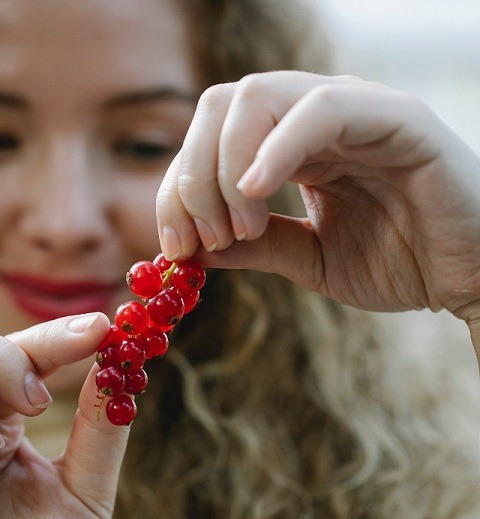
Strawberries and cherries are offered for sale on the roadside in early summer and you can’t help but buy a bowl or two. And then of course the really big ones, peach, nectarine and melon. Rather hidden in the stores, the supply of currants is not so plentiful. If they do turn up, you might even consider taking the small berries with the many stalks home with you. Those who own a few shrubs in their garden are in a privileged position. The slightly tart berries in different colors are not only a summer treat when eaten fresh, they also make delicious juice, syrup, tea, light cake toppings and occasionally a fine liqueur.
Sour quenches thirst – in the long term
While the red and white representatives of currants are descended from the European varieties ribes rubrum, ribes vulgare, ribes petraeum and ribes multiflorum , the ancestor of blackcurrants is ribes nigrum. The currant is closely related to the gooseberry. A successful cross between the two has resulted in the jostaberry, which combines the advantages of both berries: they are the size of gooseberries, are black, their skin is hairless and they are rich in vitamins. Their aroma is sweet and slightly tart with the subtle tartness of blackcurrant[i]. Whose mouth doesn’t water when you read about these berries? Juicy, sweet and sour – just the thought of the berries quenches the worst thirst. However, you shouldn’t let it get that far. Many people only drink when they are already thirsty – and therefore too late. Thirst is a warning signal from the body, indicating that it is already dehydrated[ii]. The body must be regularly supplied with fluids. Just as it is not enough to take a few deep breaths occasionally during the day and hold your breath for the rest of the day, it is not enough to drink large quantities occasionally and sit on dry land for the rest of the day. This is countered by the limited absorption capacity of our organism. It can absorb between 500 and 800 ml of fluid per hour; anything more than this is excreted unused.
If we only drink water, we can easily get the feeling that there could be more. If, on the other hand, we mix ourselves a blackcurrant spritzer, it not only supplies our body with fluids, vitamins and minerals, but the sour taste also stimulates saliva production, the oral cavity remains well moisturized in the long term, which also has an antibacterial effect, and we feel hydrated for longer.
Red, black, round – healthy!
Not only do they taste good when eaten or drunk, they are also extremely healthy. Currants are probably one of the most valuable native berries. The vitamin C content of blackcurrants is 180 mg per 100 g, while red currants only contain 40 mg. Currants are not only a healthy snack, but – if processed into juice – they can also be used well into the fall to boost the immune system before the cold season kicks off. Other ingredients of currants are the antioxidant anthocyanins, as well as potassium, calcium Chemisches Element Ca mit der Ordnungszahl 20, Mineralstoff, der zu den Mengenelementen zählt. Unter den Mineralstoffen ha…, iron, magnesium, potassium, phosphorus, fiber, gamma-linolenic acid, provitamin A, vitamins B, E, K, P, PP, pectin. The leaves contain essential oils, tannins and biophenols (quercitin, rutin).
The gamma-linolenic acid contained in currants is becoming increasingly important. People with atopic dermatitis may lack this fatty acid, so it should be supplemented[vi]. Gamma-linolenic acid is found in the seeds of currants. If you consume sufficient quantities of this, the skin’s protective and barrier function and its ability to bind moisture are restored. If you suffer from dry skin – and not just in the case of neurodermatitis – sufficient hydration is the first measure to provide relief. Human skin consists of about 80 percent water. To maintain this level of moisture, we need to drink enough – about 1.5 to 2 liters per day. This keeps the skin well supplied with blood and oxygen, its metabolism functions optimally and its barrier function is intact[vii]. This is particularly important in summer, when our skin is exposed to harmful influences such as sunlight and water when swimming. If we don’t just drink (mineral) water, but supplement our daily intake with blackcurrant juice, in which the whole berries have been processed, we kill two birds with one stone. The gamma-linolenic acid it contains improves the skin’s protective function and prevents excessive moisture loss.
Variety of drinks
Blackcurrant spritzer as a tangy refreshment, cassis as a tasty splash of color in Prosecco, called Kir Royal, the pure juice as a healthy food supplement – but that’s not all.
In naturopathy, dried currants have long been used as a medicinal tea. It alleviates rheumatic complaints, helps with diarrhea and stimulates the metabolism. The vitamin C content of the berries is also preserved during drying, so that it is not only possible to benefit from this when eating fresh berries.
To make currant tea, which is not only healthy but also a tasty addition to our daily drinking schedule, the berries and leaves of the bush are collected in the currant season around June 24 – the day on which John the Baptist, who gave his name to the small berries in this country, was born – and left to dry in a dry place away from light. After approx. one
After the first week, the berries and chopped leaves can be placed in a dark, sealable jar or tea caddy. To make a pot of redcurrant tea, pour a liter of boiling water over 30 g of the leaves, cover and leave to infuse for 10 minutes. Drink the tea – either pure or lightly sweetened with wild honey – throughout the day, as redcurrant tea is not only a healthy treat when drunk hot.
Currants – tasty fruit and all-round drinking pleasure
Whether you eat or drink them, currants are deliciously refreshing when harvested at the right time and are still effective when dried. As a juice or tea, they accompany our drinking plan throughout the year and help our skin and immune system to get through the seasons well. Small, juicy fruits that pack a punch!
